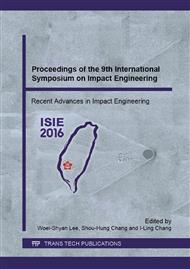[1]
Y. Matsui, Effects of vehicle bumper height and impact velocity on type of lower extremity injury in vehicle–pedestrian accidents, Accident Analysis & Prevention, 37: 4 (2005) 633-640.
DOI: 10.1016/j.aap.2005.03.005
Google Scholar
[2]
Y. Matsui, M. Hitosugi, K. Mizuno, Severity of vehicle bumper location in vehicle-to-pedestrian impact accidents, Forensic Science International, 212: 1–3 (2011) 205-209.
DOI: 10.1016/j.forsciint.2011.06.012
Google Scholar
[3]
E.M. Ossiander, T.D. Koepsell, B. McKnight, Will the light truck bumper height-matching standard reduce deaths in cars?, Accident Analysis & Prevention, 51 (2013) 292-300.
DOI: 10.1016/j.aap.2012.12.004
Google Scholar
[4]
M.M. Davoodi, S.M. Sapuan, A. Aidy, N.A. Abu Osman, A.A. Oshkour, W.A.B. Wan Abas, Development process of new bumper beam for passenger car: A review, Materials & Design, 40 (2012) 304-313.
DOI: 10.1016/j.matdes.2012.03.060
Google Scholar
[5]
G. Belingardi, A.T. Beyene, E.G. Koricho, B. Martorana, Alternative lightweight materials and component manufacturing technologies for vehicle frontal bumper beam, Composite Structures, 120 (2015) 483-495.
DOI: 10.1016/j.compstruct.2014.10.007
Google Scholar
[6]
D. -H. Kim, H. -G. Kim, H. -S. Kim, Design optimization and manufacture of hybrid glass/carbon fiber reinforced composite bumper beam for automobile vehicle, Composite Structures, 131 (2015) 742-752.
DOI: 10.1016/j.compstruct.2015.06.028
Google Scholar
[7]
Z.Q. Cheng, J.G. Thacker, W.D. Pilkey, W.T. Hollowell, S.W. Reagan, E.M. Sieveka, Experiences in reverse-engineering of a finite element automobile crash model, Finite Elements in Analysis and Design, 37: 11 (2001) 843-860.
DOI: 10.1016/s0168-874x(01)00071-3
Google Scholar
[8]
G.R. Consolazio, J.H. Chung, K.R. Gurley, Impact simulation and full scale crash testing of a low profile concrete work zone barrier, Computers & Structures, 81: 13 (2003) 1359-1374.
DOI: 10.1016/s0045-7949(03)00058-0
Google Scholar
[9]
L. Kwasniewski, C. Bojanowski, J. Siervogel, J.W. Wekezer, K. Cichocki, Crash and safety assessment program for paratransit buses, International Journal of Impact Engineering, 36: 2 (2009) 235-242.
DOI: 10.1016/j.ijimpeng.2008.05.003
Google Scholar
[10]
N. Li, H. Fang, C. Zhang, M. Gutowski, E. Palta, Q. Wang, A numerical study of occupant responses and injuries in vehicular crashes into roadside barriers based on finite element simulations, Advances in Engineering Software, 90 (2015) 22-40.
DOI: 10.1016/j.advengsoft.2015.06.004
Google Scholar
[11]
C. -H. Liu, and K. -M. Lee, Dynamic modeling of damping effects in highly damped compliant fingers for applications involving contacts, ASME Journal of Dynamic Systems, Measurement and Control, 134 (2012) 011005-1-9.
DOI: 10.1115/1.4005270
Google Scholar
[12]
K. -M. Lee, C. -H. Liu, Explicit dynamic finite element analysis of an automated grasping process using highly damped compliant fingers, Computers and Mathematics with Applications, 64: 5 (2012) 965-977.
DOI: 10.1016/j.camwa.2012.02.033
Google Scholar
[13]
C. -H. Liu, W. Chen, W. Su, C. -N. Sun, Numerical and experimental analysis of the automated demolding process for PDMS microfluidic devices with high-aspect ratio micropillars, International Journal of Advanced Manufacturing Technology, 80: 1 (2015).
DOI: 10.1007/s00170-015-6959-8
Google Scholar
[14]
R.R. Magalhaes, C.H.O. Fontes, S.A.B. Vieira de Melo, Stress analysis of a front bumper fascia using the boundary element method, Engineering Analysis with Boundary Elements, 36: 8 (2012) 1296-1300.
DOI: 10.1016/j.enganabound.2012.02.008
Google Scholar
[15]
H.A. Eschenauer, N. Olhoff, Topology optimization of continuum structures: a review, ASME Applied Mechanics Reviews, 54: 4 (2001) 331-390.
DOI: 10.1115/1.1388075
Google Scholar
[16]
G.I.N. Rozvany, Stress ratio and compliance based methods in topology optimization - a critical review, Structural and Multidisciplinary Optimization, 21: 2 (2001) 109-119.
DOI: 10.1007/s001580050175
Google Scholar
[17]
G.I.N. Rozvany, A critical review of established methods of structural topology optimization, Structural and Multidisciplinary Optimization, 37: 3 (2009) 217-237.
DOI: 10.1007/s00158-007-0217-0
Google Scholar
[18]
O. Sigmund, K. Maute, Topology optimization approaches, Structural and Multidisciplinary Optimization, 48(6) (2013) 1031-1055.
DOI: 10.1007/s00158-013-0978-6
Google Scholar
[19]
C. -H. Liu, G. -F. Huang, A topology optimization method with constant volume fraction during iterations for design of compliant mechanisms, ASME Journal of Mechanisms and Robotics, 8: 4 (2016) 044505-1-7.
DOI: 10.1115/1.4032812
Google Scholar
[20]
M. Cavazzuti, A. Baldini, E. Bertocchi, D. Costi, E. Torricelli, P. Moruzzi, High performance automotive chassis design: a topology optimization based approach, Structural and Multidisciplinary Optimization, 44: 1 (2011), 45-56.
DOI: 10.1007/s00158-010-0578-7
Google Scholar
[21]
C. Li, I.Y. Kim, J. Jeswiet, Conceptual and detailed design of an automotive engine cradle by using topology, shape, and size optimization, Structural and Multidisciplinary Optimization, 51: 2 (2015) 547-564.
DOI: 10.1007/s00158-014-1151-6
Google Scholar


